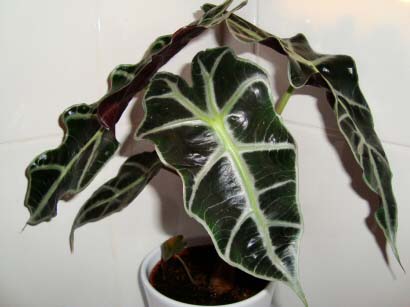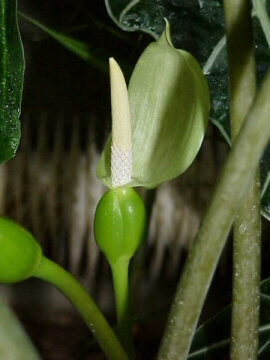





Alocasia is normally known as the Kris Plant or Elephant Ear. This unusual looking houseplant will produce flowers on occasion, however it's not brought for this reason, when it comes to an Alocasia purchase it's all about the foliage. The impressive and stunning leaves are arrowhead or shield shaped with large protruding white  veins running through them which contrasts strongly with the rest of the dark green leaf.
veins running through them which contrasts strongly with the rest of the dark green leaf.
Alocasia is the species and there are many varieties and hybrids, however the only one grown as a houseplant is "Polly" or "Amazonica". Some people will argue that they are different varieties or hybrids and "Polly" is easier to grow, although this isn't really true. At least scientifically. "Amazonica" was the original and is believed to have started appearing in homes in the 1950s, a few years later along came "Poly" (groan), when a smaller variation of "Amazonica" was found. The name "Poly" was changed to "Polly" when the plants appeal increased and started to be sold as a houseplant for commercial (and obvious) marketing reasons by nurserymen and sellers. Should you grow the two plants side by side the only difference you will find is "Polly" tends to be smaller than "Amazonica".
Alocasia can be quite difficult to keep alive as it will not accept sub standard care or incorrect conditions for very long
Under ideal circumstances there would probably be more fans of this Alien looking plant. The problem with it, is that Alocasia can be quite difficult to keep alive as it won't accept sub standard care or incorrect conditions for very long. Consequently the plant inevitable dies in a spectacular failure and the owner doesn't try to grow them again or recommend it to anyone.
Another issue is that some plants (if permitted to) enter into a dormant state and will die back during Winter. Although it normally comes back in Spring it can disappoint people to have a houseplant which is not "there" for the whole year. Both of these issues can be dealt with and we are going to tell you how. So if you like the look of Alocasia, don't be too afraid to get one!
Light
You must avoid both direct Sunlight and very dark and gloomy spots. Locations which fall between these two extremes are required.
Watering
Compost must be kept moist at all times. That's moist, not dry or soggy. The Kris Plant dislikes dryness at the roots, but too much water will cause the roots to rot. Unlike conventional house plant watering wisdom the best approach is to water little but often. If you can, make an effort to use tepid rain water.
Humidity
Another reason for this plant failing spectacularly in a home environment is because of very dry air. It's a tropical plant and needs reasonable, or high humidity. If you suffer from dry air have a look at our Humidity guide for ideas.
Feeding
A weak all purpose feed once a month is more than sufficient. Don't bother in Winter unless the plant is still activity growing, i.e. new leaves are appearing. Definitely do not feed if your Alocasia enters a die back type of dormancy (see Anything else below)
Temperature
It needs a warm spot. No lower than 15 °C / 59°F all year round. Occasional dips below this will be tolerated but longer periods will cause problems and encourage dormancy.
Repotting
This is not normally needed, but if your plant has produced lots of offsets or it has outgrown its pot it's a good idea to repot in Spring.
Propagation
You can remove any Elephant Ear offsets when you repot. The adult plant will forgive an Autumn/Fall standard repotting, but if you are repotting because you want to propagate the offsets at the same time, do it in Spring to increase your chances of them surviving.
Speed of Growth
Expect a moderate speed of growth when the days are long and the temperature warm, otherwise known as Summer.
Height / Spread
Up to 45cm / 18in in both height and  spread is usual indoors.
spread is usual indoors.
Flowers
Although flowers appear once in a while on a well looked after Alocasia, they are quite insignificant. The focus of this plant should be maintaining its beautiful foliage.
Anything else?
Some Alocasia's will enter a die back dormancy if a combination of shorter days with cooler temperatures occurs. You may be able to avoid this if the plant is moved to a warmer spot as Winter approaches. If it enters dormancy anyway don't panic, all you have to do is follow the same care guides for a growing one. The only difference is much less watering and no feeding until new shoots come back in Spring.
Copyright © www.100flowers.win Botanic Garden All Rights Reserved